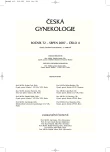The Effect of Substitution Therapy on the Birth Weight of the Newborn, its Postpartum Adaptation, Trophic and Course of the Neonatal Abstinence Syndrome
Authors:
B. Vavřinková; T. Binder
Authors‘ workplace:
Gynekologicko-porodnická klinika 2. LF UK a FN Motol, Praha, přednosta doc. MUDr. L. Rob, CSc.
Published in:
Ceska Gynekol 2007; 72(4): 247-253
Category:
Original Article
Overview
Objective:
Evaluation of the effect of substitution therapy on the birth weight of the newborn, its postpartum adaptation and course of the neonatal abstinence syndrome.
Design of the study:
A three-year prospective study.
Setting:
The Department of Gynecology and Obstetrics of the Teaching Hospital and the 2nd Medical Faculty of the Charles University, Prague.
Methods:
This prospective study was carried out in the period of 2005-2007. Included in the study were heroin-addicted pregnant women and pregnant women who undergoing methadone and buprenorphine substitution therapy. During the 3 years we followed-up 47 heroin-addicted women and 60 women under substitution therapy for prenatal screening. Of this number, 36 pregnant women were methadonesubstituted and 24 buprenorphine-substituted. Individual groups were compared using the Kruskal-Wallis ANOVA test. Correlation of dichotomic variables was evaluated by means of longlinear models. Calculations were done by means of NCSS 2002 statistical software (Number Cruncher Statistical Systems, Kaysville, UT, USA).
Results:
Statistically birth weight of newborns was significantly lowest in the group of heroin-addicted women as compared to the group receiving substitution with buprenorphine p<0.01 and as compared to the group of methadone-substituted patients p<0.05. Having monitores changes in the placenta the statistically highest number of changes was exhibited by heroin users, both when compared to methadone users (p<0.01) and buprenorphine users (p<0.001). The highest statistically significant number of newborns with IUGR symptoms were born to heroin-addicted women. The lowest Apgar score was recorded in all three evaluations in the group of buprenorphine users and the highest in methadonesubstituted women.
Conclusion:
Substitution therapy provides pregnant women with the possibility of social stabilization, adaptation, and adequate prenatal care. With regard to the fact that methadone substitution protracts the newborn’s abstinence syndrome, attention has been recently focused on substitution with buprenorphine that seems to be a more considerate option, from this point of view.
Key words:
drug abuse, substitution, methadone, buprenorphine, pregnancy
Labels
Paediatric gynaecology Gynaecology and obstetrics Reproduction medicineArticle was published in
Czech Gynaecology

2007 Issue 4
Most read in this issue
- Maternal Position at the Delivery and Perineal Trauma
- Prediction of Intrauterine Growth Retardation Using the Integrated Test Markers
- The Science-Meter Indicators (Citation index, Impact factor, Hirsch-index) and the Evaluation of the Scientific Activity in Medicine
- Occult Anal Sphincter Tear – Up-to-date Knowledge
